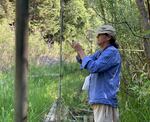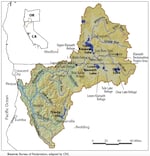
Klamath Bird Observatory Director John Alexander removes a bird from a mist net for their field station survey near Rocky Point on Upper Klamath National Wildlife Refuge.
Erik Neumann / JPR
John Alexander walks along wooden planks on the marshy edge of Upper Klamath Wildlife Refuge. Between the bullrushes and willows, a 10-foot-high black mesh “mist net” is set up to catch songbirds that are singing all around us.
“Western Tanager — kind of in the back. ‘Sweet, sweet, sweet, I’m so sweet.’ Yellow Warbler, long distance migrant. Beautiful, brilliant yellow bird,” Alexander says, identifying the birdsong around us.
Alexander is the director of the Ashland-based Klamath Bird Observatory. He’s here with a group of research biologists surveying birds at the Upper Klamath Lake field station.
“We write their band number down and then they take information about the bird’s body condition, its size, how much fat is on it,” he says.
They’ve been collecting data here since 1997. Water levels are noticeably low in the lake this year, he says.
“See where those sticks are laid up? That’s the normal water level this time of year.”
In past years, he says, “I’d be waist deep in water, with chest waders on.”
Upper Klamath Wildlife Refuge is one of six refuges in the Klamath Basin. These marshes provide temporary habitat and breeding grounds for countless songbirds and waterfowl that migrate as far as Mexico and Alaska.
“The basin as a whole in Southern Oregon, northeastern California in my opinion, and I think would be supported, is the lynchpin for migration habitat in the Pacific Flyway,” says Amelia Raquel, a biologist with the conservation group Ducks Unlimited.
When the refuges are dry, however, that habitat is gone.
In this highly managed basin, the refuges routinely end up being the lowest priority for water, after local tribes and endangered fish, and farmers who irrigate with water from the federally managed system known as the Klamath Project. Being at the end of the line can have devastating consequences.

Map of the national wildlife refuge complex in the Klamath Basin. Klamath Marsh Refuge not shown on map.
U.S. Bureau Of Reclamation / U.S. Bureau Of Reclamation
Last year tens of thousands of birds died from avian botulism. The natural waterborne bacteria thrive in warm temperatures when water is low. This year’s drought is worse, so it’s prompting some creative solutions.
On a nearby dike that divides two wetlands in Tule Lake Wildlife Refuge, shallow water is being pumped from one side to the other — from the larger Sump 1A to the smaller Sump 1B. Raquel, with Ducks Unlimited, is working on the project with local farmers like Scott Seus, as well as the U.S. Fish and Wildlife Service.
“We’re taking what precious water is here and trying to accumulate it all into one spot to save 60- to 70,000 birds that perished last year that could be proportionately more than that this year,” Seus says.
The hope is that by collecting the shallow water in one area, they’ll ward off a major botulism outbreak.
Refuge managers from the U.S. Fish and Wildlife Service declined an interview request for this story.
While there’s more attention on the drought in the Klamath Basin this year, in reality, it’s not the only reason the refuges don’t have water, according to former refuge manager Ron Cole.
Cole worked at the refuges for the Fish and Wildlife Service for 26 years, much of it as a manager. He says the allocation of local water rights and the Endangered Species Act, which protects several species of nearby fish, have deprived the refuges of the water they need to create functioning wetlands, even during normal water years.
“Thank God, we have the Endangered Species Act to help save these species,” Cole says. “But we have to implement it in such a way that we don’t create more of the same elsewhere.”
The refuges do have some water rights, on par with those of farmers who use Klamath Project water. One for Lower Klamath Wildlife Refuge was created in 1905 for 35,000 acre-feet of water per year. But, Cole says, the federal agencies involved, the U.S. Bureau of Reclamation and U.S. Fish and Wildlife Service, could never agree on how to get that water to the refuge.
Going forward, whether in drought years or not, all the different groups in the basin need to find ways to work together with the limited water that exists if anything is going to change, Cole says.
When this refuge complex can get water, he adds, managers are good at creating habitat for birds and recreation for people.
“We do know how to do those things and it worked and it wasn’t broke, but we broke it,” he says. “We broke it. That’s the saddest part of all of it is we broke that refuge and I’d like to see us put some effort into fixing it.”